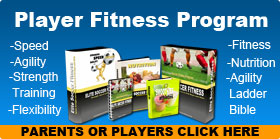Dynamic Stretching Exercises and Tips
Dynamic Stretching is key in the stretching continium. More than just stretching, it prepares the body for the activity to follow. Dynamic stretching will wake up the body, it will also stretch the muscles in an active manner.
Dynamic Stretching traditionally has been used in the athletic arena. But even everyday fitness, and weekend warriors need to use the this type of stretching. If you're not an athlete you need to wake up muscles and stretch in a dynamic fashion too.
The Dynamic Stretching section will deliver content for many populations of people. Here you will learn the how to, why, when, where, for who of dynamic stretching. Take your stretching and performance to new levels by incorporating this critical aspect of stretching in your day to day programs.Check out the helpful resources and tips sections below to expand your knowledge.
While static stretching basically means no movement, dynamic stretching equates to actively stretching through a range of motion. Scientific studies have actually shown static stretching’s negative affect on performance. It is almost as if static stretching puts the muscles to sleep. To perform optimally in your given event or exercise program perform dynamic stretching before you go into your sporting event or exercise program. This in essence will wake up the muscles. This article will help you maximally perform dynamic stretching.
What Dynamic Stretching is not?
Dynamic stretching is not ballistic stretching. Ballistic stretching has a couple disadvantages according to Allen Hedrick: “1) There is an increased danger of exceeding the extensibility limits of the tissues involved. 2) Activation of the stretch reflex.”(4 )
What is Dynamic Stretching?
It utilizes active movement to take the body part through its range of motion. This active movement prepares the muscles for exercise. Examples of dynamic stretching include: walking lunges with upper body twist, walking knee hugs and much more. It is used to both wake up and warm up the body along with stretching it.
Why
Develop Balance-One great although less mentioned benefit of dynamic stretching is its development of balance. Many of the exercises are done standing and often require you to be on one leg at a time. Various exercises like the superman (see below), leg cradles, knee hugs are one leg exercises.
Wake up the Muscles-Static stretching in essence puts the muscles to sleep (I want to point out that asleep is more of a metaphor). So immediately after performing static stretching dynamic stretching should be implemented as a way to wake up the muscles and prepare them for the exercise or event to come.
Make you stronger-Certain Dynamic stretches will actually make you stronger. According to Core Performance, “As opposed to a traditional warm-up, movement prep actually makes you stronger…”(3)
Specific way to prepare the body for exercise or sport-According to Allen Hedrick, “Dynamic flexibility provides a more sport-specific mode of stretching than does the other more commonly used stretching techniques..” I would add that it also provides movement specific warm up to everyday fitness people as well. Just because an athlete uses Dynamic flexibility does not mean that you cannot reap the benefits as well. (4)
Performance Enhancement- There is some evidence to suggest a performance enhancement with dynamic stretching. One study suggested that dynamic stretching enhanced muscular performance. (2)Another study compared static stretching, dynamic stretching with front squats and dynamic stretching. The study showed a dynamic warm-up produced greater sprint and jump performances compared to a warm-up consisting of static stretching. (1)
Warm Up the body-Dynamic Stretching will also warm up the body and the working muscles to prepare for activity.
Reduce Injuries-Because of the nature of dynamic stretching, injuries rates can go down. One person tested this on a softball team and found injury rates lower for the dynamically stretched group compared to another team on a static stretching based program.
When is the best time to perform Dynamic Stretching?
The best time is immediately before exercise or a game. After you do dynamic stretching you should then go into your exercise program or sport, ready to perform.
Where dynamic stretching should be done?
Dynamic Stretching is performed at the location of your exercise or game. If the stretching and warm up routine are done too far from your exercise location your muscles could cool down. Then you would need to go through the routine again.
Dynamic stretching requires more room than static stretching. Because of the nature of the stretches, movement will be required. Preferably you would want about 5-10 yards at least to be able to do your stretches. For athletes this is typically not an issue.
Who
Athletes, weekend warriors, and everyday fitness individuals can do dynamic stretching, unless it is contraindicated. Certain dynamic exercises could possibly cause grave damage if done under the wrong circumstances. If you had any major injuries or surgeries please consult with a doctor before you do these types of stretches. If you are elderly dynamic stretching could cause a fall risk. Consult with a doctor in this instance too. Certain types of dynamic stretches require shoulder and arm strength. If you struggle with shoulder stability or arm strength you may be unable to complete all dynamic stretches.
How-Dynamic Stretching Routine
Dynamic stretching utilizes gravity, body weight and the muscles to achieve the proper warm up and dynamic flexibility. You will stretch the muscles used in your workout dynamically, or with movement.
Design your dynamic stretching routine around the activity or sport you are doing. A swimmer's warm up routine will be different from a soccer player's. WIth that as a background lets get into routine design.
How many Repetitions?
The first measure is do you feel warmed up. There are general guidelines out there but ultimately you want muscles and a body that feels warmed up to the point where you can compete. Your objective is to warm up the muscles and wake them up.
You should shoot for approximately 5 to 10 repetitions (3) of each exercise in your dynamic stretching routine. You will find that 5 repetitions per exercise might suffice if you are quite out of shape. As you progress forward shoot for 10 repetions or maybe more if you are not warmed up.
A word of warning. Many of the exercises involved in dynamic stretching can be very difficult to do. So start slow and learn the movements first before increasing the number of repetitions.
References
- RA, N. (2009). The acute effect of different warm-up protocols on anaerobic performance in elite youth soccer players. J Strength Cond Res. , 2614-2620.
- Yamaguchi T, I. K. (2005). Effects of static stretching for 30 seconds and dynamic stretching on leg extension power. J Strength Cond Res , 677-683.
- Performance, C. (n.d.). Movement Prep. Retrieved from Core Performance: http://www.coreperformance.com/knowledge/training/movement-prep.html
- Hedrick, A. N. (October 2000). Dynamic Flexibility Training. Strength and Conditioning Journal , Vol 22, Number 5, pages 33-38.
Dynamic Stretching by Muscle
Learn How to dynamic Stretch!
Walking Knee Pulls
Classification:
Dynamic Warmup
Instructions:
1. Do the Drill Walking
2. Go up on the Toe, and pull the knee to your chest.
3. Put the leg back on the ground take a step and repeat of the opposite leg.
Walking Ground Touch
Classification:
Dynamic Warmup
Instructions:
1. Do this drill walking forward.
2. While stepping forward go down and touch the Groupnd
3. Try to keep a straight line from head through the ankle. Do not compensate by twisting the hip toward the sky. This will take the stress off the hamstring and glutes, which is where we want it.
Elbow instep
Classification:
Dynamic Warmup
Instructions:
1. Do this drill by taking a large step forward then placing the elbow in the instep of the foot on the same side.
2. Descend down after stepping forward reaching with the elbow. Use the same side elbow as the leg that stepped. If you have the flexibility try to touch the elbow to the inside of the foot.
3. After touching the foot come up to the start and repeat on the opposite leg.
Dynamic Stretching Tips
Tips to improve dynamic stretching!
- Include Dynamic Stretching into a full and complete warm up. This includes Foam Folling, followed by static stretching, followed by dynamic stretching.
- Don't use jerky motions when implementing this type of stretching. Quick jerky, over bouncing type of motions are considered ballistic stretching and could be dangerous.






